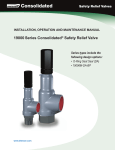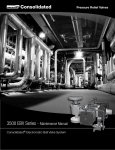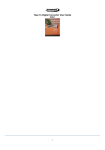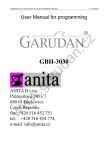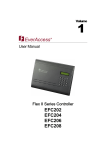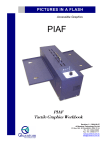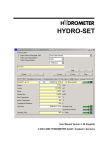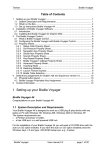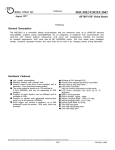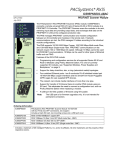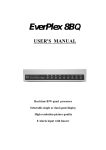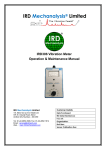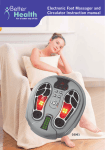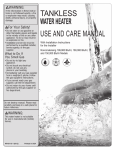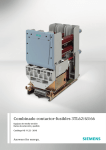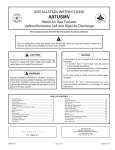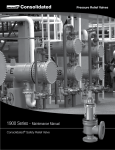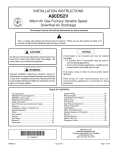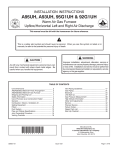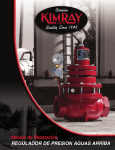Download 2700 Series - Maintenance Manual
Transcript
Pressure Relief Valves 2700 Series - Maintenance Manual Consolidated® Safety Valve Conversion Table All the USCS values in the Manual is converted to Metric values using following conversion factors: USCS Unit Conversion Factor Metric Unit1 in. 25.4 mm lb. 0.4535924 kg in2 6.4516 cm2 ft3/min 0.02831685 m3/min gal/min 3.785412 L/min lb/hr 0.4535924 kg/hr psig 0.06894757 barg ft lb 1.3558181 Nm °F 5/9 (°F-32) °C Note 1: Multiply USCS value with Conversion Factor to get Metric value. NOTICE! For valve configurations not listed in this manual, please contact your local GreentagTM Center for assistance. 2 | Dresser Consolidated® Table of Contents Section Subject Page No I. Product Safety Sign and Label System�������������������������������������������������������������������������������� 4 II. Safety Alerts������������������������������������������������������������������������������������������������������������������������� 5 III. Safety Notice����������������������������������������������������������������������������������������������������������������������� 6 IV. Warranty Information������������������������������������������������������������������������������������������������������������ 7 V. Valve Terminology���������������������������������������������������������������������������������������������������������������� 7 VI. Handling and Storage ��������������������������������������������������������������������������������������������������������� 9 VII. Introduction�������������������������������������������������������������������������������������������������������������������������� 9 VIII. Consolidated Safety Relief Valve Type 2700����������������������������������������������������������������� 10 A. Flanged Inlet����������������������������������������������������������������������������������������������������������������� 10 B. Buttweld Inlet���������������������������������������������������������������������������������������������������������������� 10 IX. Operating Principles����������������������������������������������������������������������������������������������������������� 12 X. Recommended Installation Practices��������������������������������������������������������������������������� 13 A. General Requirements�������������������������������������������������������������������������������������������������� 13 B. Outdoor Safety Valve Installation����������������������������������������������������������������������������������� 17 C. Indoor Safety Valve Installation�������������������������������������������������������������������������������������� 17 XI. Disassembly of 2700 Series Safety Valve�������������������������������������������������������������������� 18 A. General Information����������������������������������������������������������������������������������������������������� 18 B. Specific Steps������������������������������������������������������������������������������������������������������������� 18 XII. Inspection and Part Replacement�������������������������������������������������������������������������������� 20 A. General ������������������������������������������������������������������������������������������������������������������������ 20 B. Specific Components��������������������������������������������������������������������������������������������������� 20 XIII. Re-Assembly of 2700 Series Safety Valves����������������������������������������������������������������� 25 A. General Information����������������������������������������������������������������������������������������������������� 25 B. Specific Steps������������������������������������������������������������������������������������������������������������� 25 XIV. Setting and Testing��������������������������������������������������������������������������������������������������������� 28 A. General Information������������������������������������������������������������������������������������������������������ 28 B. Application of Test Gags����������������������������������������������������������������������������������������������� 28 C. Presetting Adjusting Rings�������������������������������������������������������������������������������������������� 29 D. Steam Testing Instruction���������������������������������������������������������������������������������������������� 30 E. Hydroset/Electronic Valve Testing (EVT) ���������������������������������������������������������������������� 33 F. Hydrostatic Test Plug Removal-Domestic & Export������������������������������������������������������ 33 F.1 General Information����������������������������������������������������������������������������������������������� 33 F.2 Domestic Plugs���������������������������������������������������������������������������������������������������� 34 F.3 Export Plugs ��������������������������������������������������������������������������������������������������������� 36 XV. Trouble Shooting the Type 2700 Valve ������������������������������������������������������������������������������ 37 XVI. Maintenance Tools & Supplies ������������������������������������������������������������������������������������������ 38 XVII. Replacement Parts Planning����������������������������������������������������������������������������������������� 39 A. Basic Guidelines���������������������������������������������������������������������������������������������������������� 39 B. Identification and Ordering Essentials��������������������������������������������������������������������������� 39 XVIII. Genuine Dresser Parts������������������������������������������������������������������������������������������������������ 40 XIX. Manufacturer’s Field Service & Repair Program���������������������������������������������������������� 41 A. Factory Setting vs. Field Setting������������������������������������������������������������������������������������ 41 B. Field Service����������������������������������������������������������������������������������������������������������������� 41 C. Factory Repair Facilities������������������������������������������������������������������������������������������������ 41 D. Safety Valve Maintenance Training�������������������������������������������������������������������������������� 41 Sales Office Locations ���������������������������������������������������������������������������������������������������������������������� 42 2700 Series Safety Relief Valve (July/2011) | 3 I. Product Safety Sign and Label System If and when required, appropriate safety labels have been included in the rectangular margin blocks throughout this manual. Safety labels are vertically oriented rectangles as shown in the representative examples (left and below), consisting of three panels encircled by a narrow boarder. The panels can contain four messages 1 DANGER — Immediate hazards which WILL result in severe personal injury or death. 2 Which communicate: WARNING — Hazards or unsafe practices which COULD result in severe personal injury or death. • The level of hazard seriousness. • The nature of the hazard. • The consequence of human, or product, interaction with the hazard. • The instructions, if necessary, on how to avoid the hazard.. The top panel of the format contains a signal word (DANGER, WARNING, CAUTION or ATTENTION) which communicates the level of hazard seriousness. The center panel contains a pictorial which communicates the nature of the hazard, and the possible consequence of human or product interaction with the hazard. In some instances of human hazards the pictorial may, instead, depict what preventive measures to take, such as wearing protective equipment. The bottom panel may contain an instruction message on how to avoid the hazard. In the case of human hazard, this message may also contain a more precise definition of the hazard, and the consequences of human interaction with the hazard, than can be communicated solely by the pictorial. 1 Do not remove bolts if pressure in line, as this will result in severe personal injury or death. 4 | Dresser Consolidated® 2 3 CAUTION — Hazards or unsafe practices which COULD result in minor personal injury. 4 ATTENTION — Hazards or unsafe practices which COULD result in product or property damage 3 Know all valve exhaust/ leakage points to avoid possible severe personal injury or death. 4 Wear necessary protective equipment to prevent possible injury Do not drop or strike. II. Safety Alerts Read – Understand – Practice Warning Alerts • Allow the system to cool to room temperature before cleaning, servicing or repairing the system. Hot components or fluids can cause severe personal injury or death. • Always read and comply with safety labels on all containers. Do not remove or deface the container labels. Improper handling or misuse could result in severe personal injury or death. Improper use or repair of pressurized media or steam device may result in severe personal injury or death. Heed all container label warnings. • Never use pressurized fluids/gas/air to clean clothing or body parts. Never use body parts to check for leaks or flow rates or areas. Pressurized fluids/gas/air injected into or near the body can cause severe personal injury or death. • It is the responsibility of the owner to specify and provide guarding to protect persons from pressurized or heated parts. Contact with pressurized or heated parts can result in severe personal injury or death. XXX Provide and use guarding to prevent contact with heated and/or pressurized parts. Do not work with valves while under the influence of intoxicants or narcotics. • Do not allow anyone under the influence of intoxicants or narcotics to work on or around pressurized systems. Workers under the influence of intoxicants or narcotics are a hazard both to themselves and other employees and can cause severe personal injury or death to themselves or others. • Incorrect service and repair could result in product or property damage or severe personal injury or death. • These WARNINGS are as complete as possible but not all-inclusive. Dresser cannot know all conceivable service methods nor evaluate all potential hazards. • Use of improper tools or improper use of right tools could result in personal injury or product or property damage. All potential hazards may not be covered in this manual. Improper tools or improper use of right tools could result in personal injury or product damage. • This valve product line is not intended for radioactive nuclear applications. Some valve products manufactured by Dresser Consolidated® may be used in radioactive environments. Consequently, prior to starting any operation in a radioactive environment, the proper “health physics” procedures should be followed, if applicable. 2700 Series Safety Relief Valve (July/2011) | 5 II. Safety Alerts (Contd.) Caution Alerts • Heed all service manual warnings. Read installation instructions before installing valve(s). • Wear hearing protection when testing or operating valves. • Wear appropriate eye and clothing protection. • Wear protective breathing apparatus to protect against toxic media. Note: Any service questions not covered in this manual should be referred to Dresser’s Service Department, Phone (318) 640-6055. III. Safety Notice Proper installation and start-up is essential to the safe and reliable operation of all valve products. The relevant procedures recommended by Dresser Consolidated®, and described in these instructions, are effective methods of performing the required tasks. Heed all service manual warnings. Read installation instructions before installing valve(s). It is important to note that these instructions contain various “safety messages” which should be carefully read in order to minimize the risk of personal injury, or the possibility that improper procedures will be followed which may damage the involved Dresser Consolidated® product, or render it unsafe. It is also important to understand that these “safety messages” are not exhaustive. Dresser Consolidated® can not possibly know, evaluate, and advise any customer of all of the conceivable ways in which tasks might be performed, or of the possible hazardous consequences of each way. Consequently, Dresser Consolidated® has not undertaken any such broad evaluation and, thus, anyone who uses a procedure and/or tool, which is not recommended by Dresser Consolidated®, or deviates from Dresser Consolidated® recommendations, must be thoroughly satisfied that neither personal safety, nor valve safety, will be jeopardized by the method and/or tools selected. Contact Dresser Consolidated® at (318) 640-6055 if there are any questions relative to tools/ methods. The installation and start-up of valves and/or valve products may involve proximity to fluids at extremely high pressure and/or temperature. Consequently, every precaution should be taken to prevent injury to personnel during the performance of any procedure. These precautions should consist of, but are not limited to, ear drum protection, eye protection, and the use of protective clothing, (i.e., gloves, etc.) when personnel are in, or around, a valve work area. Due to the various circumstances and conditions in which these operations may be performed on Dresser Consolidated® products, and the possible hazardous consequences of each way, Dresser Consolidated® can not possibly evaluate all conditions that might injure personnel or equipment. Nevertheless, Dresser Consolidated® does offer certain Safety Alerts, listed in Section II, for customer information only. It is the responsibility of the purchaser or user of Dresser Consolidated® valves/ equipment to adequately train all personnel who will be working with the involved valves/equipment. For more information on training schedules, call 318/640-6054. Further, prior to working with the involved valves/equipment, personnel who are to perform such work should become thoroughly familiar with the contents of these instructions. Additional copies of these instructions can be purchased, at a minimal cost, by contacting Dresser Consolidated® (in writing) at P.O. Box 1430, Alexandria, LA 71309-1430, or by calling at 318/ 640-2250, Fax (318) 640-6325. 6 | Dresser Consolidated® Wear necessary protective equipment to prevent possible injury IV. Warranty Information Warranty Statement - Dresser warrants that its products and work will meet all applicable specification and other specific product and work requirements (including those of performance), if any, and will be free from defects in material and workmanship. Defective and nonconforming items must be held for Dresser’s inspection and returned to the original F.O.B. point upon request. Incorrect Selection or Misapplication of Products - Dresser Consolidated® cannot be responsible for customer’s incorrect selection or misapplication of our products. Know nuclear “health physics” procedures, if applicable, to avoid possible severe personal injury or death Unauthorized Repair Work - Dresser Consolidated® has not authorized any nonDresser affiliated repair companies, contractors or individuals to perform warranty repair service on new products or field repaired products of its manufacture. Therefore, customers contracting such repair services from unauthorized sources must do so at their own risk. Unauthorized Removal of Seals - All new valves and valves repaired in the field by Dresser Field Service are sealed to assure the customer of our guarantee against defective workmanship. Unauthorized removal and/or breakage of this seal will negate our warranty. *Refer to Dresser’s Standard Terms of Sale for complete details on warranty and limitation of remedy and liability. V. Valve Terminology • Accumulation Accumulation is the pressure increase over the maximum allowable working pressure of the vessel during discharge through the pressure relief valve, expressed as a percentage of that pressure, or actual pressure units. • Back Pressure Back pressure is the pressure on the discharge side of a safety relief valve: 1.Superimposed Back Pressure Superimposed back pressure is the pressure in the discharge header before the safety relief valve opens. a) Constant-Specify single constant back pressure (e.g., 20 psig (1.38 barg)). b) Variable-Specify variable back pressure range using min. and max. limits (e.g., 0 to 20 psig (1.38 barg)). 2.Built-up Back Pressure Built-up back pressure is pressure which develops at the valve outlet as a result of flow, after the safety relief valve has been opened. • Blowdown Blowdown is the difference between set pressure and reseating pressure of a pressure relief valve, expressed as a percentage of the set pressure, or actual pressure units. 2700 Series Safety Relief Valve (July/2011) | 7 V. Valves Terminology (Contd.) • Cold Differential Set Pressure • Operating Pressure Cold differential set pressure is the pressure at which the valve is adjusted to open on the test stand. This pressure includes the corrections for back pressure and/or temperature service conditions. • Chatter Chatter is abnormal, rapid reciprocating motion of the moveable parts of a safety valve, in which the disc contacts the seat. • Differential Between Operating and Set Pressures Valves in process service will generally give best results if the operating pressure does not exceed 90% of the set pressure. However, on pump and compressor discharge lines, the differential required between the operating and set pressures may be greater because of pressure pulsations coming from a reciprocating piston. It is recommended that the valve be set as high above the operating pressure as possible. • Overpressure Overpressure is a pressure increase over the set pressure of the primary relieving device. Overpressure is similar to accumulation when the relieving device is set at the maximum allowable working pressure of the vessel. Normally, overpressure is expressed as a percentage of set pressure. • Rated Capacity Rated capacity is the percentage of measured flow at an authorized percent overpressure permitted by the applicable code. Rated capacity is generally expressed in pounds per hour (lb/hr) for vapors; standard cubic feet per minute (SCFM) or m3/min for gases; and in gallons per minute (GPM) for liquids. • Disc The operating pressure is the gauge pressure to which the vessel is normally subjected in service. A suitable margin is provided between operating pressure and maximum allowable working pressure. For assured safe operation, the operating pressure should be at least 10% under the maximum allowable working pressure or 5 psi (0.34 barg), whichever is greater. A disc is the pressure containing moveable member of a safety valve which effects closure. • Leak Test Pressure • Relief Valve Leak test pressure is the specified inlet static pressure at which a quantitative seat leakage test is performed in accordance with a standard procedure. A relief valve is an automatic pressure-relieving device, actuated by static pressure upstream from the valve, a relief valve is used primarily for liquid service. • Lift • Safety Relief Valve Lift is the actual travel of the disc away from the closed position when a valve is relieving. A safety relief valve is an automatic pressure-relieving device which may be used as either a safety or relief valve, depending upon application. A safety relief valve is used to protect personnel and equipment by preventing excessive overpressure. • Lifting Lever A lifting lever is a device for manually opening a safety valve, by the application of external force to lessen the spring loading which holds the valve closed. • Maximum Allowable Working Pressure Maximum allowable working pressure is the maximum gauge pressure permissible in a vessel at a designated temperature. A vessel may not be operated above this pressure, or its equivalent, at any metal temperature other than that used in its design. Consequently, for that metal temperature, it is the highest pressure at which the primary pressure safety relief valve is set to open. • Nozzle/Seat Bushing A nozzle is the pressure containing element which constitutes the inlet flow passage and includes the fixed portion of the seat closure. 8 | Dresser Consolidated® • Safety Valve A safety valve is an automatic pressure-relieving device actuated by the static pressure upstream of the valve, and characterized by rapid opening or pop action. It is used for steam, gas or vapor service. • Seat A seat is the pressure containing contact between the fixed and moving portions of the pressure containing elements of a valve. • Set Pressure Set pressure is the gauge pressure at the valve inlet, for which the relief valve has been adjusted to open under service conditions. In liquid service, set pressure is determined by the inlet pressure at which the valve V. Valves Terminology (Contd.) starts to discharge. In gas or vapor service, the set pressure is determined by the inlet pressure at which the valve pops. • Simmer Simmer is characterized by the audible passage of a gas or vapor across the seating surfaces just prior to “pop”. The difference between this “start to open pressure” and the set pressure is simmer, and is generally expressed as a percentage of set pressure. • Valve Trim Valve trim includes the nozzle and disc. VI. Handling and Storage Prevent dirt from entering outlet or inlet port. Safety valves should be stored in a dry environment to protect them from the weather. They should not be removed from the skids or crates until immediately prior to installation. Flange protectors and sealing plugs should remain installed until just prior to installation. Safety valves, either crated or uncrated, should never be subjected to sharp impact. This would be most likely to occur by bumping or dropping during loading or unloading from a truck or while moving with a power conveyor, such as a fork lift truck. The valve, either crated or uncrated, should always be kept with the inlet down (i.e., never laid on its side), to prevent misalignment and damage to internals. Even crated valves should always be lifted with the inlet down. Lift only in vertical upright position Uncrated valves should be moved or hoisted by wrapping a chain or sling, around the discharge neck, then around the upper yoke structure, in such manner as will insure that the valve is in vertical position during lift, (i.e., not lifted in horizontal position). Never lift the full weight of the valve by the lifting lever. Never hook to the spring to lift. When safety valves are uncrated and the flange protectors removed, prior to installation, meticulous care should be exercised to prevent dirt from entering the outlet port while bolting in place. While hoisting to the installation, care should be exercised to prevent bumping the valve against steel structures and other objects. VII. Introduction The “safety valve” is the final safeguard between a controlled boiler and a catastrophic explosion. In an over-pressure situation, the pressure in the valve inlet increases until the force on the disc exerted by the system pressure equals the force exerted by the spring. This causes the safety valve to pop, or lift, relieving the excess steam until the system pressure is reduced to the desired level. Handle valve carefully. Do not drop or strike. The Consolidated Safety Valve has been a leader in the industry since 1879, thus offering over a century of experience in design, engineering and product manufacturing. Dresser’s history of dependable and reliable valve service assures that today’s products and designs are consistent with industry’s current requirements. Rigid manufacturing standards controlled by an ASME approved Quality Control Program insure that each valve will be manufactured in accordance with established design criteria and tested for functional performance. This quality controlled manufacturing and test program assures that each valve manufactured will provide long and reliable service. 2700 Series Safety Relief Valve (July/2011) | 9 VIII. Consolidated Safety Relief Valve Type 2700 A. Flanged Inlet Part No. 20 1 Disc Holder 2 Guide 3 Base 4 Yoke 5 Upper Adjusting Ring 6 Upper Adjusting Ring Pin 7 Lower Adjusting Ring 8 Lower Adjusting Ring Pin 9 Spring 10 Top Spring Washer 11 Bottom Spring Washer 10 12 Seat Bushing 9 13 Disc 14 Disc Collar 15 Lift Stop 16 Spindle 17 Compression Screw 18 Compression Screw Adaptor (4 to 7_Q Orifices Only) 19 Thrust Bearing 20 Lifting Gear 14 21 Studs (Studded Inlet) 5 22 Nuts 6 23 Compression Screw Locknut 8 24 Cotter Pins (Not Shown) 2737 THRU 2777Q 20 17 19 23 17 18 4 19 16 11 10 2747 THRU 2777Q 15 1 VENT 90° OUT OF POSITION DO NOT PLUG 21 22 2 7 13 3 12 Figure 1: 2700 Safety Valve Construction - Flanged Inlet 10 | Dresser Consolidated® Nomenclature VIII.(Contd.) B. Buttweld Inlet Part No. 20 1 Disc Holder 2 Guide 3 Base 4 Yoke 5 Upper Adjusting Ring 6 Upper Adjusting Ring Pin 7 Lower Adjusting Ring 8 Lower Adjusting Ring Pin 9 Spring 10 Top Spring Washer 11 Bottom Spring Washer 10 12 Seat Bushing 9 13 Disc 14 Disc Collar 15 Lift Stop 16 Spindle 17 Compression Screw 18 Compression Screw Adaptor (4 to 7_Q Orifices Only) 19 Thrust Bearing 20 Lifting Gear 14 21 Studs (Studded Inlet) 5 22 Nuts 6 23 Compression Screw Locknut 8 24 Cotter Pins (Not Shown) 2735W THRU 2775QW 20 17 19 23 17 18 4 19 16 11 10 2745W THRU 2775QW 15 1 VENT 90° OUT OF POSITION DO NOT PLUG Nomenclature 21 22 2 7 13 3 12 Figure 2: 2700 Safety Valve Construction - Buttweld Inlet 2700 Series Safety Relief Valve (July/2011) | 11 IX. Operation Principles The 2700 Safety Valve operates on the principle that when steam pressure at the valve inlet, acting over the area of the disc seat (C) and bushing seat (A), generates a force that approaches that produced by the spring, the valve opens. Minimal leakage into the volume generated by the lower adjusting ring (B) causes additional force over a larger area acting on the disc holder (E), causing the valve to “pop” open. Proper adjustment of the upper adjusting ring allows the disc to go into full lift at overpressure. When full lift is attained, lift stop (H) rests against the yoke to prevent hunting, thus adding stability. When the inlet pressure drops to the desired closing pressure, the disc (C) moves downward, causing the valve to close. The arrangement of the disc and its complement of parts, that is disc holder (E), spindle (G), disc collar (F), and lift stop (H), allow the disc to seek its natural position for tight closure. The Thermoflex™ Disc design, by allowing for the rapid equalization of temperature around the valve seat, provides a degree of tightness far above that offered by competitive valves. H G F E C D B A Figure 3: Valve Operation 12 | Dresser Consolidated® X. R ecommended Installation Practices A. General Requirements ANCHOR DISCHARGE PIPING SOLIDLY TO BLDG. STRUCTURE RADIAL CLEARANCE REQUIRED WHEN VALVE IS OPERATING BORE EQUAL TO MINIMUM VALVE OUTLET DIAMETER VENT (SEE FIGURE 5) VERTICAL CLEARANCE REQUIRED WHEN VALVE IS OPERATING BODY DRAIN FLANGED INLET SHOWN WELDED INLET SIMILAR DRAIN X BORE EQUAL TO MINIMUM OF VALVE INLET DIAMETTER Figure 4: 2700 Valve Installation In no case may the inlet piping to the valve have a flow area less than the area of the valve inlet. Table 1: Maximum Dimension Inlet Size in. mm 3.00 76.2 Class 150 ‘X’ max in. mm 7.250 184.15 6.00 152.4 150 12.500 317.50 8.00 203.2 150 16.000 406.40 3.00 76.2 300 7.625 193.68 6.00 152.4 300 12.875 327.03 8.00 203.2 300 16.375 415.93 The valve should be installed to meet all the requirements of Figure 4. The safety valve shall be connected to the header independent of any other connection, and attached as close as possible to the header, without any unnecessary intervening pipe or fitting. “Necessary” intervening pipe or fittings shall not be longer than the face-to-face dimension of the corresponding tee fitting of the same diameter and pressure, per ANSI/ASME Standards. No valve of any description should be placed between the safety valve and the header, nor on the discharge pipe between the safety valve and the atmosphere. Excessive pressure loss at the inlet of the safety valve will cause extremely rapid opening and closing of the valve, which is known as “chattering”. Chattering may result in lowered capacity as well as damage to the seating surface of the valve. Severe chattering can cause damage to other parts of the valve. The following recommendations will assist in eliminating the factors that produce chatter: 1. The downstream corner of the header nozzle must be rounded to a radius of not less than .250” (6.35 mm) of the opening diameter. (See Figure 5) 2. Pressure drop due to friction flow to the inlet of the valve should not be greater than 50% of the expected blowdown of the safety valve. To decrease the effects of a phenomenon known as “sonic vibrations,” or “flow induced vibrations”, the following recommendations are made: 1. Safety valves should be installed at least eight to ten pipe diameters downstream from any bend in a 2700 Series Safety Relief Valve (July/2011) | 13 X. Recommended Installation Practices ( Contd. ) steam line. This distance should be increased when the valve is installed on the horizontal section of a header which is preceded by an upward section. Table 2: 2700 Yoke Vent Sizes Yoke Vent Size (NPT) Orifice Designation in. mm 2. Safety valves should not be installed closer than eight to ten pipe diameters either upstream or downstream from a diverging, or a converging, “Y”. 1 .50 12.7 2 .50 12.7 3 .50 12.7 3. In cases where a piping configuration renders the above two recommendations impractical, or impossible, the downstream corner of the header nozzle inlet should be rounded to a greater extent than the upstream corner. The header nozzle entrance should be rounded so the radius at the downstream corner will be equal to a minimum of 1/4 of the nozzle diameter. The radius should be reduced gradually, leaving only a small portion of the upstream corner with a smaller radius. (See Figure 5) 5 1 .75 19.0 4 1 .75 19.0 6 1.00 25.4 7Q 1.00 25.4 4. Safety valves should never be installed, in a steam line, in a position directly opposite to a branch line. Excessive line vibrations are known to produce shifts in safety valve set pressures. Vibrations may possibly introduce chatter, causing damage to the valve and reduce its capacity. This vibration also contributes to increased incidents of seat leakage. Considerations should be given to eliminating this problem prior to installing the valve on the unit. Note 1: #5 is a smaller orifice than #4 Steam flowing vertically out of a discharge elbow produces a downward reaction on the elbow. Effects of reaction force, vibration, and seismic loads, on all valve components and discharge piping, should be considered when designing the valve system. Refer to ANSI B.31.1, Non-Mandatory Appendix II, Dresser Product Information Sheet SV/PI-15, and Dresser Bulletin SV-5 for further information. For optimum performance, safety valves must be serviced regularly and otherwise maintained. So that servicing can be properly performed, valves should be located in a manner that allows for easy access. Sufficient working space should be provided around and above the valve to permit access to adjusting rings. If two or more valves are ANCHOR DISCHARGE PIPING SOLIDLY TO BUILDING STRUCTURE FABRICATED DRIP PAN SHOWN A A YOKE VENT SCHEDULE 40 PIPE DRAIN UNION AS CLOSE POSSIBLE SECTION A-A Figure 5: Valve Installation 14 | Dresser Consolidated® X. Recommended Installation Practices ( Contd. ) located close together, the outlets should be parallel so as to offer as much protection as possible to personnel repairing, or working close to, the safety valve. radius elbow, plus a twelve (12) inch (304.8 mm) straight length of standard weight thickness pipe (with drip pan). Because foreign material passing into, and through, a safety valve is damaging, the system on which the valve is installed must also be inspected and cleaned. New systems are prone to contain welding beads, pipe scale, and other foreign materials which are inadvertently trapped during construction, and destroy the valve seating surfaces the first few times the valve opens. 2. Clearance between the valve exhaust piping and the discharge stack should be sufficient to prevent contact when considering thermal expansion of the header, valve, and discharge stack. Movements due to vibration, temperature changes, and valve reaction forces should also be considered, to ensure adequate clearance between the exhaust piping and the discharge stack. With regard to weld-end inlet valves, completely assembled valves may be installed without disassembly being necessary at the time of welding. During welding, the valve neck should be insulated to reduce thermal stresses. When stress relieving, insulation should also be utilized to reduce thermal stresses. In service, the valve neck should be insulated at least to the point of the inlet neck/valve body-bowl juncture. Safety valves should be installed in a vertical position. Nominal tolerance on vertical installation is plus or minus 1 degree. The discharge area of the outlet piping from a safety valve should not be less than the area of the outlet connection. Where more than one safety valve is connected to a common outlet pipe, the area of the pipe should not be less than the combined area of the outlet connections to the safety valves. All safety valve discharges should be piped so that the effluent is discharged clear from walkways or platforms. Ample provision for gravity drain should be made in the discharge pipe at, or near, each safety valve where water or condensation, may collect. Each valve has an open gravity drain through the body, below the level of the valve seat, and this drain should be piped to a safe discharge area. If a silencer is used on a safety valve, it should have sufficient outlet area to prevent back pressure from interfering with the proper operation and discharge capacity of the valve. The silencer or other piping components should be constructed so as to avoid the possibility of creating corrosion deposit restrictions in the steam passages. Exhausts, drains, and vents must be installed so that they will not impose undue stresses on the safety valve. Any such stresses can produce body distortion and leakage. Therefore, the following recommendations are provided: 1. Discharge piping should not be supported by the valve. The maximum weight on the outlet of the valve should not exceed the weight of a flange and short 3. Flexible metal hoses are not generally recommended, but if used to connect valve outlets to discharge stacks, they must be of sufficient length, and be configured/installed in such a manner, that they will not become “solid” in any one position. Better results are obtained if the hoses are installed so that they will permit movement by bending, rather than by stretching and compressing along their length. The yoke can be vented to the atmosphere as in Figure 4. Precautions should be taken to vent the yoke in such a manner that it will exhaust into a safe area to prevent injury to personnel near the valve. The yoke vent piping must not be connected to the body drain piping. Do not plug the yoke vent hole or reduce vent hole pipe size, (Reference Table 2), as this could lead to valve malfunction and damage. Precautions should be taken to prevent accumulations of foreign material or water in the vent pipe. This vent is a critical part of the valve system for controlling valve blowdown and lift. All face surfaces which require gaskets, to seal pressure, shall be inspected for cleanliness, or any defects that can cause leakage. Burrs, mashed serrations, uneven surfaces, etc., are all possible leakage producing defects. Proper gasket sizes and pressure ratings should be checked prior to starting valve installation. It is of utmost importance that the gaskets used be dimensionally correct for the specific flange, and that they fully clear the valve inlet and outlet openings. Gaskets, flange facings, and bolting should meet the service requirements for the pressure and temperature involved. Other valve installation considerations include: 1. Install the inlet gasket, if required, on the header mounting flange. Check for cleanliness, surface alignment condition, gasket condition, etc. When possible, inlet studs on the mounting flange should be used to guide the valve on the header mounting flange. Inlet studs should be lubricated with the appropriate lubricant. 2700 Series Safety Relief Valve (July/2011) | 15 X. Recommended Installation Practices ( Contd. ) 2. When installing flanged valves, the flange bolts must be pulled down evenly to prevent body distortion, misalignment, and leakage. 3. With valve in position, screw on the stud nuts until all nuts are finger tight. An initial torque shall be placed, in turn, on each stud nut. Increase the torque progressively until the final torque is applied. Upon completion, recheck each stud nut’s torque. Required torque will vary with bolting material and gaskets used. See your company engineering or specification department for details on torquing sequence and torque values. As an extra precaution, the gap between the two mating flanges should be checked during the torquing process to ensure that the flanges are being pulled together evenly. A final inspection and review should be made to ensure that all of the requirements for bolting the valve inlet have been implemented. 4. The outlet piping may now be installed. A complete inspection of components and their cleanliness is to be made prior to further work. Studs are to be lubricated with an appropriate lubricant. 5. Install the outlet gasket, studs and nuts. Stud nuts are to be pulled down finger tight. An initial value of torque is to be applied. The additional procedures outlined, in Step 3 are also to be followed. After being assured that the valve is properly installed, the drainage piping from the valve body-bowl is to be connected. This line also must be flexible, so it will not create stress on the valve under operating conditions. Prior to completing the installation, a visual check should be made to ensure that the valve lifting lever has room and is free to operate. At the time of installation, an inspection of the valve should be made to confirm that all adjustment components (i.e., 16 | Dresser Consolidated® ring pins, cap, etc.) are properly locked and sealed, as required by the ASME Code. For operational hydrostatic tests at the valve inlet, which do not exceed valve set pressure, the valve should be gagged. Refer to the final “Field Testing” portion of this manual for proper techniques. Ensure that the gag is removed upon completion of the inlet hydrostatic test. Prior to startup of the unit on steam, the sections of this manual which specify requirements for set pressure testing should be reviewed. For conditions where the valve is subjected to high steam pressures (i.e., those exceeding normal operating conditions), preparations should be made to gag the valves. These preparations should then be cleared with the boiler manufacturer and Dresser Consolidated® Engineering. Refer to Section XIV. B.3 of this manual for the proper gagging techniques. The safety valve should be tested with full steam pressure to ensure that the safety valve installation has been properly accomplished. In some cases this is not practical, thus the use of the Consolidated® Hydroset, or the Electronic Valve Tester (EVT), should be considered. For valves being tested for set pressure by using a Hydroset or EVT, only the set pressure is being verified. Other factors such as blowdown, lift, reaction force, proper discharge stack sizes and effects of thermal expansion cannot be determined, using these setting devices. Full flow steam testing is recommended at initial start-up to adjust blowdown and verify proper installation. Proper adjusting ring position can then be recorded and maintained when valves are serviced. Vent and drain piping should have a union connection to facilitate valve removal or servicing in place. (See Figure 4) X. Recommended Installation Practices ( Contd. ) B. Outdoor Safety Valve Installation Safety valves operating under the best possible conditions (i.e., of favorable operating gap, relatively stable ambient temperatures, the absence of dirt and in relatively still air) will provide the maximum degree of safety, tightness and dependability. When a safety valve is installed in an outdoor location, it may be exposed to wind, rain, snow, ice, dirt and varying temperatures. Therefore, the following recommendations are made for proper protection, and to ensure that operational dependability can be restored to a level near that of the valve installed under ideal conditions: Know all valve exhaust/ leakage points to avoid possible severe personal injury or death. The inlet neck of the safety valve and safety valve body, up to the top of the base, should be insulated. The exterior surface of any such insulation should be made weather-proof by any suitable means. In addition to maintaining a more even temperature within the valve body, especially during widely fluctuating ambient temperatures, this insulation will effectively reduce thermal stresses, due to high temperature gradients, through the walls of the safety valve nozzle. Spring covers should be used to stabilize (as nearly as possible) the temperature of the spring, to prevent the accumulation of snow and ice between the coils of the spring, and to prevent dirt and fly ash from accumulating between the coils of the spring. Lifting gear covers should be installed to prevent ice, dirt and fly ash from accumulating in areas inside the safety valve cap. C. Indoor Safety Valve Installation Indoor valve installations should have inlet necks insulated only up to the underside of the valve body. Considerations should be given to ambient temperature changes greater than 100°F (37.8°C), because of possible set point changes which may occur. 2700 Series Safety Relief Valve (July/2011) | 17 XI. Disassembly of 2700 Series Safety Valve A. General Information The Type 2700 Safety Valve can be easily disassembled for inspection, reconditioning seats or replacing internal parts. The initial spring load can be established after reassembly. (Refer to Figure 1 and 2 for parts nomenclature). NOTES: • Before starting to disassemble the valve, be sure that there is no steam pressure in the drum or header. • Parts from one valve should not be interchanged with parts from another valve. B. Specific Steps 1. Remove the top lever pin and top lever. 2. Loosen cap set screw and lift off cap and drop lever assembly. 3. Remove the cotter pin which retains the release nut, and then remove the release nut. 4. Refer to Figure 6, and measure and record Dimension A, as this information will be required to correctly re-assemble the valve. Do not disassemble valve with pressure in drum or header, as this will result in severe personal injury or death. 5. Loosen the compression screw locknut and the compression screw, to remove tension from the spring. 6. Loosen and remove the yoke stud nuts. DISC DISC COLLAR DEPTH MICROMETER DISC HOLDER SPINDLE A LIFT STOP COMPRESSION SCREW COMPRESSION SCREW LOCKNUT SOFT METAL VISE YOKE Figure 6: Yoke Disassembly 18 | Dresser Consolidated® Figure 7: Spindle Disassembly XI. Disassembly of 2700 Series Safety Valve (Contd.) 7. Carefully lift the yoke and spring assembly over the spindle, and away from the valve. micrometer or other suitable measuring device. Record Dimension B. 8. Remove the thrust bearing assembly and the spring washer assembly. Mark the spring to indicate the top of the spring, as this formation will be used in reassembly. 12. Place a scale or other thin flat metal surface against the lower face of the upper adjusting ring and measure from the top of the guide to the face of the upper adjusting ring (Dimension C, Figure 8). Record Dimension C. 9. Remove the spindle, disc and disc holder assembly from the valve by lifting the spindle. Take care to ensure that the disc seating surface is not damaged from improper handling. 10. To remove the disc and disc holder from the spindle, first insert the spindle into a vise (see Figure 7) being careful not to damage the threaded end of the spindle. Then, lift up on the disc holder and turn the disc/disc holder counterclockwise to engage the “drop-thru” threads. Once the threads are engaged, release the disc holder and continue to unthread and remove the disc. After the disc is removed, lift disc holder from the spindle. Note: Removal of the lift stop and/or the disc collar from the spindle is usually unnecessary, unless the spindle is to be replaced. 11. Measure from the top of the guide to the bushing seat (Dimension B, Figure 8) with a depth 13. Remove the upper adjusting ring pin from the valve base. 14. Loosen the lower adjusting pin until the pin is slightly clear of the notches in the lower adjusting ring. Being careful not to move the lower adjusting ring, place a ring lap on top of the bushing seat. (See Figure 9). Then, using the ring pin as a “pointer”, or reference point, rotate the lower adjusting ring counterclockwise and count the number of notches that pass in front of the “pointer” until contact is made with the ring lap. Record this information, as it will be required to correctly reassemble the valve. 15. Remove both the lower adjusting ring pin and the lower adjusting ring from the valve base. 16. The valve is now ready to be cleaned and the parts inspected for proper size and condition. UPPER ADJ. RING PIN RING LAP B C LOWER ADJUSTING RING SEAT SCALE SEAT BUSHING LOWER ADJ. RING PIN Figure 8: Bushing Seat Figure 9: Placing a Ring Lap on Top of the Seat Bushing 2700 Series Safety Relief Valve (July/2011) | 19 XII. Inspection and Part Replacement A. General Once the valve is disassembled, appropriate parts can be inspected for damage and their suitability for reuse. B. Specific Components 1. Lift Lever and Cap Assembly Visually inspect the lift lever and cap assembly for damage from improper handling or severe corrosion. Components should be replaced if damage interferes with proper function or manual lifting of the valve. 2. Compression Screw and Locknut The compression screw must be replaced if the threads are damaged to the point that spring adjustment is affected. The wrench flats should not be worn or rounded or distorted due to the improper use of an adjusting wrench on either the compression screw or locknut. The spring washer bearing surface or compression screw adapter surface, (5 through Q orifice only), should not be pitted or torn and should have a 32 RMS finish. 3. Thrust Bearing The aligning washer must match evenly to the lower thrust bearing spherical surface, such that full face contact is achieved between the parts. Therefore, grind together, or replace the entire thrust bearing, as necessary. lateral binding. Overgagging is one of the common causes of bent spindles. A method to check the essential working surfaces of the spindle is illustrated in Figure 10. This may be performed either with or without the disc collar and lift stop on the spindle. a. Using Figure 10 as a reference, clamp a V block (A) made of wood, fiber or other suitable material onto the platform railing. Imbed the ball end of the spindle in a piece of soft wood (B) and place the top of the Spindle, below the threads, in the V block (A). Clamp a dial indicator onto the railing and locate at point (C). The total indicator reading should not exceed .007” (0.18 mm) when the spindle is rotated. If it does, the spindle must be straightened prior to reuse. b. To straighten the spindle, place the unthreaded portion of the small and large end in padded V blocks, with the point of maximum indicator readout upward, and then apply a downward force with a padded press or jack as required, until the spindle is within the specifications. c. Other parts of the spindle not used as working surfaces may run out considerably more than A X X A 4. Top and Bottom Spring Washers The lower spring washer bearing surface must be ground to the spindle. To grind the lower spring washer, a 320 grit (Clover 1A) lapping compound is used for roughing-in, and then finish lap with 1000 grit Kwik-AkShun lapping compound until a satisfactory bearing band is obtained. The bearing width should be 1.800” (3.20 mm) min. to 3.160” (4.80 mm) max. Clean lower spring washer and spindle when complete. 450 Section X-X C 5. Spring Visually inspect for pitting and corrosion of coils that will reduce the coil diameter. When this condition is found, replace the spring. Inspect for end parallelism in the free height and any obvious unevenness in coils, collapse of coils or general distortion. B 6. Spindle It is important that the spindle be kept very straight in order to transmit the spring force to the disc without 20 | Dresser Consolidated® Figure 10 XII. Inspection and Part Replacement (Contd.) DISC SPINDLE SPINDLE NOSE SEAT STEP BEARING BAND WIDTH R FLAT DIAMETER Figure 12: Disc to Spindle Lapping DISC RING LAP FLAT SURFACE Figure 11 .007” (0.18 mm), but this should not be regarded as unacceptable. Although the upper thread end is not a working surface, excessive bending in this area could effect the accuracy of the Dresser Consolidated® Hydroset device and/or the Dresser Consolidated® Electronic Valve Tester, if either of these devices is used to verify valve set pressure. d. Apply a small amount of lapping compound (1A) on the tip of the spindle. Install the disc - without the disc holder - onto the spindle tip, turning it clockwise until the disc threads drop out. Place a ring lap on a table, or similar flat surface, and wipe the exposed surface of the lap clean. Insert the disc nose into a ring lap, so that the seat contacts the lap surface. Oscillate the spindle using 360 degree oscillations for approximately 15 seconds, then check the spindle tip and disc “pocket” to determine progress. (See Figure 11). Figure 13 e. The spindle nose should be ground into the disc pocket until the bearing is clearly marked. The band position is shown in Figure 12. f. Place the disc holder on the spindle, allowing it to rest on the face of the disc collar as previously shown in Figure 7 on Section XI.B. Then assemble the disc holder and new disc. The disc should be free enough to rock on the spindle tip. If there is no freedom, lower the disc collar until the disc is free to rock slightly initially, approximately .001 to .002” (0.25 to .05 mm) rock. The disc collar must then be lowered two additional notches from this initial position and secured with a stainless steel cotter pin. (See Figure 13). Note: Failure to provide the recommended disc rock at assembly will result in a leaking valve. 2700 Series Safety Relief Valve (July/2011) | 21 XII. Inspection and Part Replacement (Contd.) upper ring will adjust, even when the valve is hot. If serious galling is present, the guide should be replaced. Table 3: Disc to Spindle Lapping Information Nose Radius Orifice in. mm Flat Bearing Diameter Band Width in. mm in. mm a. Clearance — The maximum clearance between the disc holder and guide should be in accordance with Table 4. 1 .277 +- .000 .004 7.04 +- 0.00 0.10 .125 3.18 .125 3.18 2 .377 +- .000 .004 9.42 +- 0.00 0.10 .313 7.94 .125 3.18 8. Disc Holder 3, 5, 4, 6 + 0.00 .495 +- .000 .005 12.57 - 0.13 .250 6.35 .219 5.56 Q + 0.00 .582 +- .000 .005 14.78 - 0.13 .250 6.35 .281 7.14 Table 4: Allowable Guide / Disc Holder Clearance Orifice #1 #2 #3 #5 #4 #6 #Q Temp. Class B D B D B D B D B D B D B D Maximum Clearance in. .005 .008 .008 .012 .010 .015 .011 .017 .012 .018 .016 .016 .025 .025 mm 0.13 0.20 0.20 0.30 0.25 0.38 0.28 0.43 0.30 0.46 0.41 0.41 0.64 0.64 g. The desired band width for Type 2700 valves is shown in Table 3. In addition, the finished machined size of the spindle nose radius, and the flat diameter for each orifice size, are also shown in this Table. If the required bearing band cannot be obtained by hand grinding, then this radius should be checked and remachined if necessary. h. If the band extends too high on the radius it will be difficult to rock the disc, and the disc may lock up under pressure. If the band is too narrow, the spindle may indent the disc and again the rock will be lost. i. When the bearing area is re-established, clean both surfaces. Then apply lubricant to the spherical surface of the spindle tip, and work it into the surfaces by rotating the disc on the spindle. 7. Guide Inspect the guide inside diameter for egging, and ensure the inside surface is smooth. The threads on the outside must be in good condition to ensure the 22 | Dresser Consolidated® The surface on the end of the disc holder closest to the disc must be free from steam erosion. The two small holes must be open to ensure the passage of steam to the chamber above the disc. Make sure the outside diameter is not egg shaped and the surface is smooth. If any small indication of galling is present, polish the high spots with an emery cloth. If serious or large scale galling is present, the disc holder should be replaced. 9. Disc Inspect the disc seat for steam cuts, nicks, or other damage. If the seat step measures less than dimensions specified in Table 5, this indicates that the thermal lip has been lapped to the minimum thickness. Do not machine any ThermoDisc™; however, a disc which is not below minimum relief can be lapped to remove minor damage. a. To Lap Disc Seat (i) The above lapping method is also used on the disc seat. When lapping the disc seat, the disc should be held stationery, but not rigidly, and the lap moved as above. Use care not to strike the cone of the disc, as this would cause the seat to be high on the inside. (ii) The ThermoDisc™ can not be machined. If, after lapping, Dimension M, in Figure 14, does not meet the minimum specified in Table 5, the disc should be replaced. (iii) It may not be necessary to use all the laps at any one time, but having a sufficient supply on hand will save reconditioning time. The laps should be reconditioned on a flat lapping plate. A lap should not be used on more than one valve without being reconditioned. Laps must be checked for flatness prior to use, and at frequent intervals during use. A lap that is flat within one-half light band is considered satisfactory. Information on XII. Inspection and Part Replacement (Contd.) diameter, and outside of the bushing, to establish the correct height, angles, and diameters. BEARING SURFACE X b. The use of a reseating machine is suggested for reconditioning badly worn seats, or for re-establishing Dimension E per Figure 15. Dimension E should be re-established when it is less than .010” (0.25 mm) for orifices 1, 2, 3, 5 and 4; and less than .030” (0.76 mm) for orifices 6 and Q. M min. SURFACE L c. To lap the bushing seat. Note: If the bushing seat surface requires extensive lapping or reconditioning, a reseating machine should be used prior to lapping. Figure 14 (i) Cover the seat lap face with a light coating of 1-A Clover Compound and gently place the lap on the valve bushing seat. Table 5: Minimum Seat Relief M min. Orifice #1 #2 #3 #5 #4 #6 #Q in. mm .004 .005 .006 .007 .008 .010 .012 0.10 0.13 0.15 0.18 0.20 0.25 0.30 Note: A heavy coat of lapping compound tends to round off the edges of the seat. (ii) Lap, using an oscillating motion in various directions, while holding the lap loosely in the fingers and allowing the weight of the lap to rest on the seat surface. Control the motion of the lap to prevent either the inside or outside edge of the lap from crossing the bushing seat surface. If either edge touches the seat surface, the seat can become scratched and/ or rounded. the Monochromatic Light and optical flat is available, upon request, from the Dresser Consolidated® Field Service Department. (iv)To recondition a ring lap, wipe all compound from the lapping plate and ring lap, then move the ring lap in a figure-eight motion on a lapping plate. If the lap is not flat, a shadow will be apparent. To remove the shadow, coat the lapping plate with 1000 Grit Compound and lap the ring, with figure-eight motions covering the lapping plate. Note: Care should be used not to run off the seating surface with the lap, as this will cause the seat to become uneven. (iii) Do not lap excessively with a ring lap without resurfacing on a lapping plate. Use a new ring lap, if further lapping is required, to remove E 10. Seat Bushing a. A Dresser Consolidated® reseating machine should be used to recondition badly worn, out of tolerance, bushing seats. This machine can be provided by the Dresser Consolidated® Service Department, and eliminates the need to remove a valve from the unit. The machine is mounted in place of the yoke and cuts the top face, inside D Figure 15 2700 Series Safety Relief Valve (July/2011) | 23 XII. Inspection and Part Replacement (Contd.) any defect in the seat. To finish lapping the bushing seat, apply a light coating of #1000 Grit Compound to the face of the new lap, and repeat the lapping motion described previously. (iv)Remove the ring lap and wipe the lap surface with a clean, lint free cloth, leaving compound on the bushing seat. Replace the ring lap on the seat and lap as above, but without adding compound. Repeat this operation until the seat has a mirror finish. Any evidence of defects, such as gray areas or scratches, will require a repeat of the whole lapping procedure until a mirror finish is attained. (vi)The following precautions and hints will be of assistance when lapping nozzle and/or disc seats: • Two (2) ring laps per valve • 1 A Clover Grinding Compound per tool list1 • 1 000 Grit Kwik-Ak-Shun Compound per tool list1 • Clean, lint free cotton rags Note 1:This tool list is located on Section XV of this manual. (v) While the finer points of lapping and “grindingin” may be considered as a mechanical art, it is not beyond the ability of the average mechanic to produce good seats with some practice. No effort has been made in this manual to establish an exact procedure to cover each and every case, because different persons can get the same results using their own techniques. d. Before lapping the nozzle and disc seat, the leading edges (inside diameter of seats) of both must be slightly chamfered as follows: Use a fine grade sandpaper to lightly break the inner edge and outer edge of the nozzle seat and disc seat. The purpose of this is to remove any small metal particles or fins attached to the sharp corner surfaces. Do not exceed .002” (0.05 mm) chamfer for this purpose. e. Seat Bushing should be replaced if D dimension is below the values mentioned in Table 6. Table 6: Seat Bushing Replacement Criteria Orifice #1 24 | Dresser Consolidated® Grinding D min. in. .125 mm 3.18 #2 .203 5.16 #3 .250 6.35 #5 .313 7.95 #4 .313 7.95 #6 .500 12.70 #Q .438 11.13 XIII. Re-Assembly of 2700 Series Safety Valve A. General Information The Type 2700 Safety Valve can be easily re-assembled after required inspection/maintenance of internal parts has been performed. All parts should be clean prior to assembly. See Section XVI for recommended compounds, lubricants, and tools. B. Specific Steps 1. Prior to reinstalling the lower adjusting ring, lubricate the threads of the lower adjusting ring pin and partially insert the pin into the valve body. Now the pin can again serve as a “pointer”, or reference point, as previously described in Section XI.B. of “Disassembly”. 2. Lubricate the threads of the lower adjusting ring, and install the ring in the valve body. Then, turn the lower adjusting ring clockwise until the top of the ring clears the seat. 3. The lower adjusting ring is to be installed in the position it originally held prior to disassembly. To effect this relocation, place a clean ring lap on the nozzle seat and turn the lower adjusting ring in a counterclockwise direction until it makes contact with the ring lap. If the original location of the adjusting ring was recorded, simply lower the ring, by turning it clockwise, the same number of notches as was recorded in Step XI.B. of “Disassembly”. If information on the original lower ring position is not available, the ring should be lowered, by turning it clockwise one notch for every 600 psig (20.7 barg) of set pressure. This position represents a staring position. See Note below. Note: For a valve set pressure of 1200 psig (81.6 barg), the ring will have to be lowered two (2) notches below the bushing seat. This will be the starting position, with the final position being determined during field testing. 4. Once the lower adjusting ring is in its correct location, lock it in place by installing in the lower adjusting ring pin. Verify that the lower ring is capable of a slight movement. If the lower ring does not move, the pin is too long. Should this be the case, grind the end of the pin slightly to shorten it, while retaining the original tip contour, then reinstall the pin. 5. If the upper adjusting ring has been removed from the guide, lubricate the ring threads and re-install the ring on the guide. 6. Install the adjusting ring and guide assembly into the valve base such that the scribe marks will be visible from the valve outlet or the inspection port. 7. Measure the overall length of the upper ring and guide assembly. Adjust the upper ring to the Dimension C recorded in Step 12 of Section XI.B., Disassembly. Observe the marks made on the ring and guide and adjust the ring to align the marks. Recheck the overall length of the adjusting ring and guide assembly to assure that the upper ring is in its original position. 8. Measure from the top of the guide to the bushing seat with a depth micrometer. Subtract Dimension B as measured in Step 11, Section XI.B. of Disassembly, Table 7: General Adjusting Ring Information Orifice Pressure Class Total Number of Notches Number of Notches Disc Holder to Seat Lower Ring Upper Ring Lower Ring Upper Ring Vertical Ring Travel for each Notch of Adjustment Lower Ring Upper Ring in. mm in. mm #1 All 18 22 7 10 .0035 0.089 .0025 0.064 #2 All 21 31 8 12 .0030 0.076 .0020 0.051 #3 All 31 41 12 16 .0020 0.051 .0015 0.038 #5 All 31 37 12 17 .0020 0.051 .0015 0.038 #4 All 31 47 12 16 .0020 0.051 .0015 0.038 #6 All 41 56 30 45 .0015 0.038 .0010 0.025 Q All 48 62 30 45 .0015 0.038 .0010 0.025 2700 Series Safety Relief Valve (July/2011) | 25 XIII. Re-Assembly (Contd.) from the dimension previously measured. The difference is the distance the upper adjusting ring must be lowered. Refer to Table 7 to determine the number of notches that the ring is to be lowered. 9. Once the upper adjusting ring/guide assembly is properly set, lubricate the guide seating surface in the valve base, and re-install the assembly into the base, then, lubricate the threads of the upper adjusting ring pin, and lock the ring/guide assembly in place by installing in the pin. 10. Verify that the upper ring is capable of a slight movement. If the upper ring does not move, the pin is too long. Should this be the case, grind the end of the pin to shorten it, while retaining the original tip contour, then reinstall the pin. 11. Clamp the spindle in a padded vise, with the “ball end” of the spindle upward. 12. Verify that the spindle bearing has been ground to the disc pocket, as specified in Section XII.B.6.e., of this manual. Note: This step must be accomplished before proceeding with re-assembly. 13. If the lift stop was removed from the spindle, lubricate the threads and install the lift stop. Do not install the cotter pin at this time. 14. If the disc collar was removed, lubricate the threads and install on the spindle. Do not install the cotter pin at this time. Then, carefully lower the disc holder onto the spindle, allowing it to sit on the face of the disc collar. 15. The disc onto the spindle, ensuring that the disc is free to “rock” on the spindle tip as specified in Section XII.B.6.f., of this manual. If disc “rock” is not satisfactory, correct the cause before proceeding. 16. When disc “rock” is satisfactory, remove the disc and disc holder, and secure the disc collar with a stainless steel cotter pin. Using side cutters, carefully cut-off excess cotter pin legs, and bend the cotter pin for a neat installation. 17. Lubricate the spindle tip, and assemble the disc holder and disc to spindle. Recheck the rock. 18. Remove complete assembly from the vise, being sure to protect the disc seat surface at all times. 19. Prior to installing the spindle assembly into the valve base, wipe the disc seat with a soft, lint-free cloth. Then, carefully install the spindle assembly into the guide. 20. Lubricate the compression screw threads with “FelPro Nickel Ease”, and thread into the yoke. Install the lower washer on the spring and, then, install the upper washer on the spring. Lubricate the bearing assembly with “Fel-Pro Nickel Ease” and install on the upper spring washer. 21. For orifice sizes 5-Q, next place the compression screw adaptor on top of the bearing. Table 8: Required Lift for Capacity Verification Capacity Lift Orifice Required Additional Lift Total Lift 1 & 2 in. mm in. mm in. mm 1 .281 7.14 .020 0.51 .301 7.65 Approx. 31 Notches 2 .338 8.59 .020 0.51 .358 9.09 Approx. 36 Notches 3 .450 11.43 .030 0.76 .480 12.19 Approx. 48 Notches 5 .516 13.11 .050 1.27 .566 14.38 Approx. 62 Notches 4 .563 14.30 .040 1.02 .603 15.32 Approx. 56 Notches 6 .750 19.05 .060 1.52 .810 20.57 Approx. 81 Notches Q .987 25.07 .070 1.78 1.057 26.85 Approx. 106 Notches Note 1: For full lift valves only .020” + 0.51 mm . Per the ASME Section I code, the valve lift must be Note 2: Total lift tolerance is +- .000” [ - 0.00 mm ] mechanically verified and shall meet or exceed the required lift. 26 | Dresser Consolidated® XIII. Re-Assembly (Contd.) 22. Place the spring and bearing assembly into the yoke. 23. Lubricate the yoke studs with “Fel-Pro Nickel Ease”. Carefully lower the yoke/spring assembly over the spindle while aligning the yoke as shown in Figure 17 of Section XIV. Ensuring that the yoke vent hole is on the side of the valve opposite the inspection port, make certain that the yoke does not bind on the lift stop. Care should then be taken to tighten down the yoke evenly, so as to prevent distortion and misalignment. 24. Raise the lift stop until it contacts the yoke. Then, lower the lift stop to achieve the proper dimension shown in Table 8, or the restricted lift identified on the valve nameplate. Note: Do Not Deviate From Stamped Nameplate Lift. The lift stop must be adjusted to the rated lift marked on the nameplate, plus an additional amount as indicated. The additional lift is to compensate for heated condition of the lower spindle when the valve is in operation. Note: For all Type 2700 valves, one revolution of the lift stop equals .063” (1.59 mm) of lift. There are six (6) notches on the lift stop, so each notch of adjustment represents approximately .010” (0.25 mm) lift. 25. Secure the lift stop with a cotter pin. DEPTH MICROMETER SPINDLE A COMPRESSION SCREW COMPRESSION SCREW LOCKNUT 26. Refer to Figure 16 and establish Dimension A to that previously recorded in Section XI.B.4 of “Disassembly”. 27. Ensure that the top washer arms do not remain in contact with the yoke, after each compression screw adjustment. 28. The valve is now ready for testing, after which the following steps can be taken: a. Following testing, the compression screw should be locked firmly in place with the lock nut. b. Install the release nut onto the spindle; then, thread clockwise until the release nut is fully engaged on the spindle thread and the cotter pin hole is aligned. For numbers 1, 2, 3, and 4 orifices, run the release nut down enough to allow the lock nut to fully engage, and then, loosely install the lock nut. c. Install the cap over the release nut, and seat the cap firmly into place on the yoke. Install the top lever in the cap and, then, insert the top lever pin through the top lever and cap holes. d. Adjust the release nut, until it clears top lever by .125” (3.20 mm). Remove the lever pin, top lever and cap. Next, insert a cotter pin through the release nut slots and the spindle, and spread the cotter pin ends. Re-assemble the cap with the drop lever, top lever, and top lever pin. Install a cotter pin to lock the top lever pin in place. A final check should be made to ensure the proper clearance exists between the release nut and the top lever. Finally, tighten the cap set screw to secure the cap. 29. After testing the valve for proper set point and blowdown, the ring pins, top lever pin and lift stop shall be sealed. Run a continuous wire through the sealing wire holes leaving both ends in such a manner that a lead seal may be threaded to them. Before crimping the seal, assure that the parts being sealed can not be tampered with, without removing the seal. YOKE Figure 16 2700 Series Safety Relief Valve (July/2011) | 27 XIV. Setting and Testing A. General Information Upon completion of hydrostatic testing of the boiler, but prior to placing the boiler in service, ENSURE THAT THE HYDROSTATIC TEST PLUGS ARE REMOVED FROM ALL VALVES. All Type 2700 Safety Valves are steam tested at the factory to verify set pressure adjust ability and seat tightness. Every valve is set to have a clean popping action and to reseat tightly. However, because the boiler used in setting the valves has a small capacity, compared to the capacities of the Type 2700 Valves, the valves are factory set with a long blowdown to prevent chattering under initial start-up conditions. Final adjustments should be made on the operating system with conditions approximately those that will be realized under actual operating conditions. Note: D resser Consolidated® recommends full flow steam testing upon initial start up. Adjusting ring settings are initial adjustments only and are not intended to be final adjustments. The use of a Dresser Consolidated® Hydroset or EVT, unit can serve to establish set pressure but cannot be used for verifying blowdown,lift, etc. (For additional information, see Section X. Recommended Installation Practices, of this manual). It is recommended that the safety valves be tested and adjusted with the boiler isolated. Factors which can affect valve operation, and which should be considered when initially setting a valve, are as follows: 1. Ambient temperature near the valve and valve temperature stabilization. 2. Line vibration. 3. Valve capacity versus rated flow through the line on which the valve is mounted. 4. Discharge stack or drain piping binding. 5. Flow induced vibrations or pressure pulsations set up by upstream bends. Valve inlet nozzle configuration, or other internal piping configuration problems. 6. High water level in the drum. When the valves are subjected to working hydrostatic 28 | Dresser Consolidated® tests not exceeding the set pressure of the low set valve, valves may be gagged rather than using hydrostatic test plugs. For higher pressures, hydrostatic plugs should be used. A common source of safety valve trouble is over-gagging. During hydrostatic testing, and during safety valve setting, gags should be applied only hand tight. During setting, over gagging will also cause damage to the seating surface and result in seat leakage. The gag load applied should be only enough to ensure that the valves do not lift at the expected overpressure. During start-up, gags should never be applied when the boiler is cold. The spindle of the safety valve expands considerably with the temperature increase. If it is not free to expand with this temperature change it may become seriously overstressed and bent. Except for hydrostatic tests, boiler pressure should be brought up to within 80% of the pressure of the low set valve before applying gags. Tighten the gags of drum and superheater valves finger tight. When adjusting the ring positions of a valve, the valve must be gagged to prevent accidental lifting and personal danger. If testing the set pressure of a valve, the other valves in the system should also be gagged. B. Application of Test Gags (All Pressures) 1. Refer to Figure 17. Remove top lever pin and top lever, then loosen the cap screw. Remove cap and drop lever as an assembly. The release nut is fixed to the spindle by means of a cotter pin. Note that the release nut does not quite engage top of compression screw. 2. Center the test gag in the exposed end of the SPINDLE and hook the legs of gag under the sides of the YOKE. Do not apply the gag load until the system steam pressure is equal to 80% of the pressure to which the low set valve is adjusted. 3. Apply the gag load by turning the gag screw clockwise. If the gag on any valve has not been tightened sufficiently, the valve will leak. On steam service the leakage is accompanied by a “Sizzling” sound. XIV. Setting and Testing (Contd.) If this occurs, the hydrostatic test pressure or steam pressure should be reduced until the valve becomes tight and, then, the gag should be tightened still further. This procedure must be followed exactly, since it is very difficult to stop the leak by additional gagging once it has started. Any attempt to stop the leakage through the valve, without first lowering the system pressure, could result in damage to the valve seats. 4. After the hydrostatic test or steam test is completed, the gags should be removed when the hydrostatic pressure has been reduced to 80% to 90% of the pressure of the low set valve. Note: Under no circumstances should the gags be left on the valves during normal boiler operation. C. Presetting Adjusting Rings 1.Remove the caps on all valves to be set on the steam drum and main steam line. 2.Install a currently calibrated pressure gauge on the drum near the valve being set. When main steam valve are to be set, install the calibrated gauge upstream from the valves on the main steam line to read line pressure. 3. After the pressure in the boiler has increased to 80% of operating pressure, install gags on all boiler valves not being tested. Gags should be installed hand tight, (no wrenches or mechanical force). 4.On the valve to be tested, use the following procedure and Table 9, to bring the adjusting ring to seat level. a) Gag the valve to prevent the disc from accidentally lifting from the seat during adjustment. b) Remove both service port plugs. c) Remove the upper ring pin. d) Move the upper ring until it is level with the disc holder. e) From this point, move the upper adjusting ring down, (from right to left as viewed through the service plug hole), counting the number of notches until the number in Column “B” in Table 9, appropriate to the orifice size is reached. This will establish the upper adjusting ring at seat level. GAG Table 9: Adjusting Ring Seat Level Orifice 1 2 3 5 4 6 7Q Lower Ring Seat Level Adjustment in Notches Upper Ring Seat Level Adjustment in Notches (Column A) (Column B) 7 8 12 12 12 30 30 10 12 16 16 16 45 45 Gag safety valve during ring adjustments to avoid possible severe personal injury or death. 2700 Series Safety Relief Valve (July/2011) | 29 XIV. Setting and Testing (Contd.) f) Adjust the upper adjusting ring as indicated in the upper ring Column of Table 10 use either the Saturated Column or Superheated Column as conditions warrant g) Replace the ring pin in the valve to hold the upper adjusting ring in position without binding. h) Remove the lower ring pin. i) Move the lower adjusting ring up until it contacts the disc holder. j) After referring to Table 9, lower the adjusting ring the number of notches indicated in Column “A” This setting will place the lower adjusting ring at seat level. k) Once the lower adjusting ring is at seat level it can be preset to the beginning test position by moving the adjusting ring down one notch for each 600 psi (41.37 bar) or part thereof. (Example: 1,000 psi (68.95 bar) Set Pressure = 2 notches.) l) Replace the adjusting ring pin in the valve to hold the lower adjusting ring in position without binding. 5.Wire the adjusting ring pins together to prevent them from loosening and vibrating out under pressure. 6. Replace the service port plugs. 7.Remove the gag from the valve to be tested, and reinstall the cap and lever assembly on the valve. 8. Now the valve is ready for steam testing. D. Steam Testing Instructions 1. Attach a rope to the lifting lever on the valve to be tested. 2. Increase the boiler pressure at a rate not to exceed 2 psi (0.14 barg) per second. Note and record the pressure indicated on the pressure gauge when the valve “pops” open. After the valve pops open, reduce the fire in the boiler and lower the pressure until the valve closes, note and record the pressure when the valve closes. If in raising the boiler pressure, the valve doesn’t open within 3% overpressure (for ASME Section I valves), or 10% overpressure (for ASME Section VIII valves), reduce the fire in the boiler and pull the rope to open the valve. 30 | Dresser Consolidated® 3. Determine if the valve popping point and reseating points comply with the ASME requirements for valve operation as recorded in Table 10. (See ASME Boiler and Pressure Code Section I, or Section VIII Valve Operation Standards for more details). To determine which standard to use, look at the nameplate on the valve. The symbol that is present on the nameplate will indicate the proper standard of operation. (See Table 11) 4. If the valve operation is in compliance with the standard, proceed to step 7. 5. If the valve is not in compliance, reduce boiler pressure to approximately 85% of valve set pressure. GAG the safety valve being adjusted. a) If set pressure is out of compliance turn the compression screw one sixth of a turn (clockwise to raise set pressure, and, counterclockwise to lower set pressure). Retest, and note the change in set pressure for one sixth turn-then calculate the number of turns needed to bring the set pressure to the desired pressure. Adjust as necessary. b)If the blowdown is excessive, raise the upper adjusting ring (5 to 10 notches). If the blowdown is insufficient, lower the upper adjusting ring (5 to 10 notches). Re-test as in step 2, if the blowdown is not within specification repeat step 5. 6. Remove the gag, and repeat Step 2, raising the pressure until the valve pops then proceed with the following steps until the subject valve is in compliance with the appropriate standard. 7. After one pop has been determined to be in compliance, test the valve two more times for consistency of set pressure and blowdown. Allow a minimum of 10 minutes between pops. If the operation remains in compliance with the standard, reduce the boiler pressure to approximately 85% of the set pressure and seal the valve cap and adjusting ring pins. 8. Proceed to the next valve to be tested. 9. When all valve have been tested and sealed, return the boiler to normal operating pressure. (See Table 12) XIV. Setting and Testing (Contd.) Table 10: Adjusting Ring Presetting Information1 Orifice Area Set Pressure Range Orifice in 2 #1 0.994 #2 1.431 #3 cm 2 6.413 9.232 2.545 16.419 #5 3.341 21.555 #4 3.976 25.652 #6 7.070 45.613 Q 12.250 79.032 Note 1: Note 2: Note 3: Note 4: min. psig 101 301 501 901 1501 2501 2801 101 301 501 901 1501 2501 2801 101 301 501 901 1501 2501 2801 101 301 501 901 1501 2501 2801 101 301 501 901 1501 2501 2801 101 301 501 901 barg 6.96 20.75 34.54 62.12 103.49 172.44 193.12 6.96 20.75 34.54 62.12 103.49 172.44 193.12 6.96 20.75 34.54 62.12 103.49 172.44 193.12 6.96 20.75 34.54 62.12 103.49 172.44 193.12 6.96 20.75 34.54 62.12 103.49 172.44 193.12 6.96 20.75 34.54 62.12 max. psig barg 300 20.68 500 34.47 900 62.05 1500 103.42 2500 172.37 2800 193.05 3000 206.84 300 20.68 500 34.47 900 62.05 1500 103.42 2500 172.37 2800 193.05 3000 206.84 300 20.68 500 34.47 900 62.05 1500 103.42 2500 172.37 2800 193.05 3000 206.84 300 20.68 500 34.47 900 62.05 1500 103.42 2500 172.37 2800 193.05 3000 206.84 300 20.68 500 34.47 900 62.05 1500 103.42 2500 172.37 2800 193.05 3000 206.84 300 20.68 500 34.47 900 62.05 1100 75.84 All Pressures Lower Ring Position 2, 4 1N down per 600 psig. (413.68 barg) Max. 5N down 1N down per 600 psig. (413.68 barg) Max. 5N down 1N down per 600 psig. (413.68 barg) Max. 5N down 1N down per 600 psig. (413.68 barg) Max. 5N down 1N down per 600 psig. (413.68 barg) Max. 5N down 1N down per 600 psig. (413.68 barg) Max. 5N down 1N down per 600 psig. (413.68 barg) Max. 3N down Saturated Steam (Temp. Class B) Upper Ring2 Upper Ring3 (Seat) (Disc Holder) Seat Level 10N (down) 20N (up) 10N (up) 20N (up) 10N (up) 15N (up) 5N (up) 10N (up) 3N (down) 10N (up) 3N (down) 5N (up) 8N (down) Seat Level 12N (down) 20N (up) 8N (up) 20N (up) 8N (up) 15N (up) 3N (up) 10N (up) Level w/ Holder 10N (up) Level w/ Holder 5N (up) 7N (down) Seat Level 16N (down) 25N (up) 9N (up) 25N (up) 9N (up) 20N (up) 4N (up) 15N (up) Level w/ Holder 15N (up) Level w/ Holder 15N (up) Level w/ Holder 8N (down) 25N (down) 50N (up) 34N (up) 40N (up) 24N (up) 40N (up) 24N (up) 40N (up) 24N (up) 45N (up) 29N (up) 45N (up) 29N (up) 9N (down) 25N (down) 55N (up) 38N (up) 50N (up) 33N (up) 45N (up) 28N (up) 45N (up) 28N (up) 45N (up) 28N (up) 45N (up) 28N (up) Seat Level 45N (down) 70N (up) 25N (up) 65N (up) 20N (up) 60N (up) 15N (up) Seat Level 45N (down) Superheated Steam (Temp. Class D) Upper Ring2 Upper Ring3 (Seat) (Disc Holder) Seat Level 10N (down) Seat Level 10N (down) Seat Level 10N (down) 5N (down) 15N (down) 10N (down) 23N (down) 10N (down) 23N (down) 15N (down) 28N (down) Seat Level 12N (down) Seat Level 12N (down) Seat Level 12N (down) 5N (down) 17N (down) 10N (down) 22N (down) 10N (down) 22N (down) 15N (down) 27N (down) Seat Level 16N (down) Seat Level 16N (down) Seat Level 16N (down) 10N (down) 26N (down) 20N (down) 36N (down) 20N (down) 36N (down) 20N (down) 36N (down) 8N (down) 25N (down) Seat Level 16N (down) 10N (down) 26N (down) 10N (down) 26N (down) 15N (down) 31N (down) 25N (down) 41N (down) 25N (down) 41N (down) 9N (down) 25N (down) Seat Level 17N (down) 10N (down) 27N (down) 15N (down) 32N (down) 20N (down) 37N (down) 25N (down) 42N (down) 25N (down) 42N (down) Seat Level 45N (down) Seat Level 45N (down) 10N (down) 55N (down) 20N (down) 65N (down) ½ Turn Below Seat Level 81N (down) For pressures over those listed in this table, use the same ring setting as the highest listed pressures. Position reference to seat level Position reference to the bottom of disc holder. If valve is to be tested on superheated steam, set lower ring at seat level. 2700 Series Safety Relief Valve (July/2011) | 31 XIV. Setting and Testing (Contd.) Table 11: Nameplate Symbols ASME Boiler and Pressure Vessel Code Section and Symbol Set Pressure Tolerance (The valve must “POP” open within the range indicated below.) Blowdown Requirements If valve set pressure is less than or equal to 70 psig (4.83 barg) ± 2 psig (0.14 barg) V CODE SYMBOL STAMP ASME Section I If valve set pressure is 71 psig (4.90 barg) up to and including 300 psig (20.68 barg) ± 3% of set pressure If valve set pressure is 301 psig (20.75 barg) up to and including 1000 psig (68.75 barg) ± 10 psig (±0.69 barg) After opening, the valve must reclose within a range of 98% to 96%, however, if the valve set pressure is 100 psig (6.89 barg) or less the valve must reclose within a range of 2 to 4 psig (0.14 to 0.28 barg) below set pressure. If valve set pressure is 1001 psig (69.02 barg) or greater ±1% of set pressure UV CODE SYMBOL STAMP ASME Section VIII If valve set pressure is less than or equal to 70 psig (4.83 barg) ± 2 psig (±0.14 barg) If valve set pressure is 71 psig (4.90 barg) or greater After opening the valve must reclose before the system pressure returns to normal operating pressure. ± 3% of set pressure Table 12: Recommended Operating Gap Boiler Design Pressure Minimum Differential as a Percent of Boiler Design Pressure Over 15 to 300 psig (1.03 to 20.68 barg) 10% but not less than 7 psi (0.48 barg) Over 300 to 1000 psig (20.68 to 68.95 barg ) 7% but not less than 30 psi (2.07 barg) Over 1000 to 2000 psig (68.95 to 137.90 barg ) 5% but not less than 70 psi (4.83 barg) 32 | Dresser Consolidated® XIV. Setting and Testing (Contd.) E. Hydroset/Electronic Valve Testing (EVT) Periodic tests may be required for verification of valve set pressure. Both the Dresser Consolidated® Hydroset Test Device and EVT provide for this capability; however, set pressure is the only factor which can be verified. Valves should be initially set using full system pressure (as outlined in sections XIV.A. through XIV.C. of this manual). The Hydroset, or EVT used for subsequent checks of set pressure. Setting safety valves by the recommended method of lifting valves under steam pressure presents a number of problems. In high pressure conventional boilers, superheater tubes may be damaged if the turbine is not operating. Also, the expense of feed water, fuel and personnel involved is considerable. Improper lift adjustment may result in severe personal injury or death. Although these problems cannot be eliminated entirely, they can be reduced by using a hydraulic or electronic device that allows the set pressure to be checked, while the system pressure remains below the set pressure. Accuracy of results obtained by the use of either of these devices depends on several factors. First, friction must be reduced as a source of error so that, for a given pressure, the Hydroset or the EVT repeatedly produces exactly the same lifting force. Second, gauge calibration and vibration, in the effective seating area between valves of the same size and type, will also affect accuracy. With well calibrated gauges and valve seats in good condition, accuracy on the order of ±1% of set pressure may be expected. Upon request, Dresser Consolidated® will provide pertinent written material concerning the Dresser Consolidated® Hydroset Device, or the EVT. This material specifies all required information necessary to ensure proper usage of these devices. F.Hydrostatic Test Plug Removal-Domestic & Export F.1 General Information Flanged inlet safety valves shipped without Hydrostatic Test Plugs should be removed from the boiler during hydrostatic tests and boiler nozzles blanked off to prevent possible valve damage. Do not disassemble valve with pressure in drum or header, as this will result in severe personal injury or death. All valves shipped outside the continental United States are shipped with an export hydroplug (See Figure 20). All welded inlet valves shipped within the continental United States are shipped with a domestic hydroplug (See Figure 19), unless the customer specifically requests otherwise. All flanged inlet valves shipped within the continental United States are shipped without a hydroplug, unless one is specifically requested by the customer. Valves shipped with either type of hydroplug are identified by a Red on White CAUTION TAG which is attached to the valve by wires extending through the drain hole in the valve body. (See Figure 18) 2700 Series Safety Relief Valve (July/2011) | 33 XIV. Setting and Testing (Contd.) CAUTION O OVED REM IS DO NOT STEAM TEST UNTIL THE PLUG HAS BEEN E REMOVED LU T G DO NOT REM This safety valve is equipped with an internal plug for hydrostatic test V HIS TA G U N T I L P SERVICE PLUG DRAIN HYDRO PLUG Figure 17: Hydrostatic Test Plug Hydrostatic test plugs must be removed prior to firing boiler. The hydrostatic plugs are placed in the bore of the valve, inside the seating surface. Their purpose is twofold. First, they effect closure at a point differing from the seating surface of the valve so that, if the valve is lifted on hydrostatic test, the seating surface is not as likely to be damaged. Second, by raising the disc of the valve off its seat and increasing spring compression, the set pressure of the valve is increased to a point where the valve will not 34 | Dresser Consolidated® leak at one and one-half times design boiler pressure. It is not necessary to gag the safety valves when hydrostatic plugs are used. These plugs must, of course, be removed from the valves prior to placing the boiler in service. However, they should be retained, and reinstalled, whenever a hydrostatic test is conducted which exceeds the low set valve pressure. Before starting to disassemble the valve, be sure that there is no steam pressure in the drum or header. XIV. Setting and Testing (Contd.) F.2 Domestic Plugs To remove the domestic plug, the following steps must be followed: SPINDLE 1. Remove the cap assembly, adjust release nut to 2nd hole from the top of the spindle and install cotter pin. 2. Back off the yoke stud nuts uniformly until compression screw engages release nut. Now remove yoke stud nuts. 3. Yoke and spring assembly, (See Figure 20), from base, being careful not to damage the disc. 4. Remove the hydrostatic test plug from the seat bushing. This may be accomplished by inserting a threaded rod into the tapped hole in the plug and lifting up until free from bushing. Care should be taken as not to damage the seat bushing. 5.Remove the disc from the disc holder by turning clockwise until it is disengaged from spindle threads. DISC HOLDER HYDROPLUG PLUG SEAT BUSHING Note:Hold the disc holder against the disc adjusting collar during this step, otherwise the disc holder will fall from the spindle and become damaged. 6. Lap the disc and seat bushing and thoroughly clean the seats with a clean cloth. 7. Lubricate the spindle tip with “Anti-Seize”, and assemble the disc and disc holder to spindle by turning the disc until the dropout threads disengage. 8. Reassemble yoke and spring assembly (See Figure 20) into base, being careful not to damage the disc. Locate the yoke vent to the side of the valve. The lug on the top spring washer should be on the right side of the valve when facing the outlet. Figure 18: Domestic hydrostatic plug Table 13: Yoke Nut Torque Values Nut Torque Orifice Designation ft-lbs Nm 1 60 81.35 2 60 81.35 3 110 149.14 5 170 230.49 9. Replace the yoke and the stud nuts. Tighten the stud nuts according to Table 13. 1 4 375 508.43 6 375 508.43 10. Remove cotter pin from release nut and position release nut so that .125” (3.17 mm) of clearance is visible between lifting fork and release nut, then install cotter pin. 7Q 375 508.43 1 Note 1: #5 is a smaller orifice than #4. 11. Install cap and lever assembly. 12. Valve is now ready for the initial field test on steam in order to check valve set point and blowdown. 2700 Series Safety Relief Valve (July/2011) | 35 XIV. Setting and Testing (Contd.) F.3 Export Plugs When hydrostatic plugs are installed in 2700 Valves scheduled for shipment to foreign countries, the disc is removed and dipped in preservative, then packed in a box. The package is then inserted into the valve outlet. To remove the special export plug, the following steps must be followed: 1. Remove the cap assembly, adjust release nut to 2nd hole from the top of the spindle and install cotter pin. 2. Back off the yoke stud nuts uniformly until compression screw engages release nut Now remove yoke stud nuts. SPINDLE DISC HOLDER EXPORT HYDROPLUG SEAT BUSHING Figure 19: Export Hydrostatic Plug 3. Remove yoke and spring assembly, (See Figure 20), from base. 4. Remove hydrostatic plug by turning until it is disengaged from spindle threads. Note: Hold the disc holder against the disc adjusting collar during this step, otherwise the disc holder will fall from the spindle and become damaged. 5. Remove the seal peel preservative from the disc. 6. Lap the disc and seat bushing, thoroughly clean the seats with a clean cloth. 7. Lubricate the spindle tip with “Anti-Seize”, and assemble the disc and disc holder to spindle by turning the disc until the dropout threads disengage. 8. Reassemble yoke and spring assembly (See Figure 20) into base being careful not to damage the disc. Locate the yoke vent to the side of the valve. The lug on the top spring washer should be on the right side of the valve when facing the outlet. 9. Replace the yoke and the stud nuts. Tighten the stud nuts according to Table 13. 10. Remove cotter pin from release nut and position release nut so that .125” (3.17 mm) of clearance is visible between lifting fork and release nut, then install cotter pin. 11. Install cap and lever assembly. 12. Valve is now ready for the initial field test on steam in order to check valve set point and blowdown. Figure 20: Yoke and Spring Assembly 36 | Dresser Consolidated® XV. Trouble Shooting The 2700 Valves Problem No Action, Valve does not go into full lift. Simmer Valve Leaking and/ or exhibits erratic popping actions. Hangup, or valve does not close completely. Excessive blowdown Chatter or short blowdown Possible Cause Corrective Action A. Upper ring too high. A. Increase blowdown as outline in Section XV.C.4. of this manual. B. Foreign material trapped between disc holder & guide. B. Disassemble valve and correct any abnormality as outline in Section XI. of this manual. Inspect system for cleanliness A. Lower ring too low. A. Adjust per Section XV.C.2. of this manual. B. Steam line vibrations B. Investigate and correct cause A. Damaged seat A. Disassemble valve, lap seating surfaces, replace disc if required, as outlined in Section XIX.B. of this manual. B. Part misalignment. B. Disassemble valve, inspect contact area of disc and nozzle, lower spring washer or spindle, compression screw, spindle straightness, etc. C. Disc has insufficient rock. C. Disassemble valve and check disc rock per Section XIX.E. of this manual. D. Discharge stack binding on outlet. D. Correct as required. A. Lower ring too high. A. Move lower ring to the left one notch per adjustment and test. Repeat until problem is eliminated. B. Foreign material. B. Disassemble valve and correct any abnormal condition. Inspect system for cleanliness. A. Upper ring too low. A. Decrease blowdown as outlined in Section XV.C.3. of this manual. B. Exhaust pressure too high. B. Decrease exhaust pressure by increasing discharge stack area. A. Upper ring too high. A. Lower upper ring. B. Inlet piping pressure drop too high. B. Reduce inlet pressure drop to less than one-half of required valve blowdown by redesigning inlet piping. C. Yoke vent is plugged. C. Clear yoke vent. 2700 Series Safety Relief Valve (July/2011) | 37 XVI. Maintenance Tools and Supplies Lapping Tools Gags The following tools are required for proper maintenance of Consolidated® Type 2700 Safety Valve seats Valve Orifice Gag Part No. 1 VJ5920 Ring Lap 2 VJ5920 The ring lap is used for lapping the nozzle and disc seats. 3 4363001 5 4363001 Ring Laps 4 4363001 Lap Part NO. 6 4363001 1 1672806 Q 4363001 2 1672807 3 1672808 5 1672810 4 1672809 1 Valve Orifice 2 Lubricant Location 6 1672811 Bearing Points Q 1672812 1. Spindle/Disc Note 1:One set of (2) Ring Laps is recommended for each orifice valve in service, to assure ample flat laps are available at all times. Note 2:Valve orifice number is third digit of valve type number, e.g. a 2737A valve has a #3 orifice. Lapping Plate The lapping plate is used for reconditioning the ring laps. Only one 11’’ (279.40 mm) diameter plate is required for all sizes of ring laps. Lubricant 2. C ompression Screw/ Top Spring Washer Fel-Pro Nickel Ease 3. Spindle/Bottom Spring Washer All Threads All Nut Contact Faces Wrench Sizes Yoke Stud Size Wrench Size 2700 Orifice in. mm in. Resurfacing Plate – 11’’ (279.40 mm) Diameter. (Part No. 0439004) #1 .625 - 11 thd. 15.88 - 11 thd. 1-1/16 #2 .625 - 11 thd. 15.88 -11 thd. 1-1/16 Lapping Compound #3 .750 - 10 thd. 19.05 - 10 thd. 1-1/4 #5 .875 - 9 thd. 22.23 - 9 thd. 1-7/16 #4 .875 - 9 thd. 22.23 - 9 thd. 1-7/16 #6 1.125 - 7 thd. 28.58 - 7 thd. 1-13/16 #Q 1.125 - 7 thd. 28.58 - 7 thd. 1-13/16 Lapping compound is used as a cutting medium for lapping and polishing the seats and bearing surfaces in Type 2700 Safety Valves. Brand Grand Grit Lapping Size Part No. Function Container Clover 1A 320 General 4 oz. 199-3 Clover C 220 Coarse 4 oz. 199-2 Kwik-Ak-Shun - 1000 Polishing 1 lb. 199-11 2 oz. 199-12 38 | Dresser Consolidated® XVII. Replacement Parts Planning A. Basic Guidelines The basic objectives in formulating a replacement parts plan are: Guidelines for establishing meaningful inventory levels: Part Classification Parts Classification Replacement Frequency Predicted Availability • SENSIBLE COST CLASS I Most Frequent 70% • SOURCE CONTROL CLASS II Less Frequent But Critical 85% CLASS III Seldom Replaced 95% CLASS IV Hardware 99% CLASS V Practically Never Replaced 100% • PROMPT AVAILABILITY • MINIMUM DOWNTIME Consult the Recommended Spare Parts list to define the parts to be included in the inventory plan. Select parts and specify quantities. B. Identification and Ordering Essentials Explanation of Name Plate The valve nameplate contains several necessary pieces of information necessary to the proper operation of the valve. Included are: • • ASME, and National Board of Boiler and Pressure Vessel Inspectors Approval Stamp Serial Number • Set Pressure or Opening Pressure Disc Lift • Operating Temperature • Capacity 2700 Valve Series nameplate is located on the base of the valve, to the left of the Adjusting Ring Pins. If the nameplate is missing, a duplicate nameplate can be supplied by Dresser Flow Control. To order the replacement nameplate, call the Dresser Consolidated® Field Service Supervisor at (318) 640-6055, with the valve serial number as stamped on the top of the discharge flange of the valve. Valve Type • • Table 14 Standard Valve Connection Inlet Size Area Temperature Class Designation Class Designation Range 6.41 5 600# ANSI B TO 750°F (398.89 °C) 1.431 9.23 6 900# ANSI D TO 1050°F (565.56 °C) 3 2.545 16.42 7 1500# ANSI 76.20 5 3.341 21.55 3.0 76.20 4 3.976 25.65 4.0 101.60 6 7.070 45.61 6.0 152.40 7Q 12.250 79.03 in. mm 1.5 38.10 2.0 Orifice Pressure Class in2 cm2 1 0.994 50.80 2 2.5 63.50 3.0 2700 Series Safety Relief Valve (July/2011) | 39 XVII. Replacement Parts Planning (Contd.) TYPE NB CERTIFIED BY V 2749 WB-2-S SERIAL NO. 3 SIZE SET PRESS. 1500 BT 23514 .563 PSI LIFT CAP. 464900 B/M 9259201 IN LBS / HR AT °F DATE Figure 21: Valve Identification VALVE TYPE CODING Flanged Inlet: 27 3 7 B Series Temp. Class Orifice Designation Pressure Class Buttweld Inlet: 27 3 7 W B Series Temp. Class Orifice Designation ButtWeld Inlet Pressure Class XVIII. Genuine Dresser Parts The next time replacement parts are needed, keep these points in mind: • Dresser Consolidated designed the parts • Dresser Consolidated® guarantees the parts • Consolidated® valve products have been in use since 1879 ® 40 | Dresser Consolidated® • Dresser Consolidated® has worldwide service • Dresser Consolidated® has fast response availability for parts XIX. Manufacturer’s Field Service & Repair Program A. F actory Setting vs. Field Setting Every Consolidated® Safety Valve is set and adjusted on steam before shipment from the factory. Ring adjustments are made at the factory. However, it must be recognized that actual field operating conditions may vary considerably from factory test conditions. Conditions beyond the manufacturer’s control that affect Safety Valve operation include: • Improper header nozzle design • Quality of media being discharged • Discharge piping stresses and back pressure • Ambient temperature • Shipping or storage damage • Improper gagging • Damage due to foreign material in the steam Final Safety Valve adjustments made on the actual installation are the best means of ensuring that the valves perform in compliance with the ASME Boiler Code and/ or other applicable code requirements. B. Field Service Utilities and Process Industries expect and demand service at a moment’s notice. Consolidated® Field Service can be depended upon for prompt response, even in extreme off-hour emergency situations. Dresser Consolidated® maintains the largest and most competent field service staff in the industry. Service Engineers are located at strategic points throughout the United States to respond to customer’s requirements for service. Each Service Engineer is factory trained and long experienced in servicing Safety Valves. Dresser Consolidated® Service Engineers restore disc and seat bushing critical dimensions which affect valve performance, and are capable of modernizing valves in the field. All Field Service Engineers’ activities are coordinated from the Alexandria, Louisiana, Field Service Office. Upon receipt of a purchase order number authorizing the trip, the engineer is dispatched. Reference: www.consolidatedvalve.com to locate your local Field Service representative. C. Factory Repair Facilities The factory at Alexandria, Louisiana maintains a Consolidated® Repair Center. The repair department, in conjunction with the manufacturing facilities, is equipped to perform specialized repairs and product modifications, e.g. bushing replacements, hydroset calibrations, electromatic relief valve repairs, etc. Contact: Valve Repair Department at (318) 640-6057. D. Safety Valve Maintenance Training Rising costs of maintenance and repair in the Utility and Process Industries indicate the need for trained maintenance personnel. Dresser Industrial Valve Operation conducts service seminars that can help your maintenance and engineering personnel to reduce these costs. Seminars, conducted either at your site, or at our Alexandria, Louisiana manufacturing plant, provide participants with an introduction to the basics of preventative maintenance. These seminars help to minimize downtime, reduce unplanned repairs and increase valve safety. While they do not make “instant” experts, they do provide the participants with “Hands On” experience with Consolidated Valves. The seminar also includes valve terminology and nomenclature, component inspection, trouble shooting, setting and testing, with emphasis on the ASME Boiler and Pressure Vessel Code. For further information, Please contact the Product Training Manager by fax at (318) 640-6325, or telephone (318) 640-6054. It is highly recommended that the professional talents of a Dresser Consolidated® Field Service Engineer be employed to make final field adjustments during the initial setting of all Consolidated® Safety Valves. 2700 Series Safety Relief Valve (July/2011) | 41 Sales Office Locations UNITED STATES FRANCE Dresser Consolidated® Dresser, Inc. LA Hwy. 3225 @ US Hwy. 167N P.O. Box 1430 Alexandria, LA 71309-1430 Telephone: + (1) 318 640 2250 Fax: + (1) 318 640 6325 Dresser Flow Technology Europe Energy 5 - 130/190 Bd de Verdun 92413 Courbevoie Cedex, France Tel: + (33) 1 49 04 90 00 Fax: + (33) 1 49 04 90 10 Dresser Consolidated® Headquarters 10343 Sam Houston Park Drive Suite 210 Houston, TX 77064 Telephone: +(1) 281 671 1640 Fax: +(1) 281 671 1735 Dresser Direct 1250 Hall Court Deer Park, TX 77536 Telephone: + (1) 281 884 1000 Fax: + (1) 281 884 1010 Dresser Direct 905A Industrial Road Clute, TX 77531 Telephone: + (1) 979 265 1309 Fax: + (1) 979 265 2514 Dresser Direct 4841 Leopard Street Corpus Christi, TX 78408 Telephone: + (1) 361 881 8182 Fax: + (1) 361 881 8246 BRAZIL Dresser Industria E Comercio Ltda Rod. Presidente Dutra, KM 154, 7 Predio 18 - Pq Industrial CEP 12240-420 San Jose dos Campos, Sau Paulo, Brazil Telephone: + (55) 11 2146 3600 Fax: + (55) 11 2146 3610 CHINA Dresser Machinery (Suzhou) Co., Ltd. 81, Suhong Zhong Road Suzhou Industrial Park Suzhou, P.R. China 215021 Telephone: + (86) 512 6258 6500 Fax: + (86) 512 6258 8590 Dresser, Inc. Suite 1703, Capital Mansion 6 Xinyuan S. Road, Chaoyang District Beijing 100004 P.R. China Telephone: + (86) 10 8486 4515 Fax: + (86) 10 8486 5305 42 | Dresser Consolidated® GERMANY Dresser Valves Europe GmbH Heiligenstrasse 75 41751 Viersen, Germany Tel: + (49) 2162 8170 0 Fax: + (49) 2162 8170 280 INDIA Dresser Valve India Pvt. Ltd. 305/306, “Midas”, Sahar Plaza Mathuradas Vasanji Road J B Nagar, Andheri East, Mumbai, India 400 059 Telephone: + (91) 22 2 835 4790 / 838 1134 Fax: + (91) 22 2 835 4791 ITALY Dresser Italia S.r.l. Via Cassano 77 80020 Casavatore (Naples), Italy Telephone: + (39) 081 7892 111 Fax: + (39) 081 7892 308 JAPAN Dresser Japan,Ltd. (DJL) 20th Floor Marive East Tower WBG 2-6 Nakase Mihama-ku Chiba-shi Chiba 261-7120 Japan Telephone: + (81) 43 297 9211 Fax: + (81) 43 299 1115 KOREA Dresser Korea, Inc. Hyundai Swiss Tower, 17 Floor 143-40, Samsun-don Kangham-ku Seoul 135-090, Korea Telephone: + (82) 2 2274 0748 Fax: + (82) 2 2274 0720 Sales Office Locations MALAYSIA SOUTH AFRICA Dresser, Inc. Asia Pacific Headquarters Business Suite 19A-9-1, Level 9 UOA Centre, No. 19 Jalan Pinang 50450 Kuala Lumpur, West Malaysia Telephone: + (60) 3 2161 0322 Fax: + (60) 3 2163 6312 Dresser International, Ltd., South Africa Branch Dresser Flow Solutions P. O. Box 2234, 16 Edendale Road Eastleigh, Edenvale 1610 Republic of South Africa Telephone: + (27) 11 452 1550 Fax: + (27) 11 452 2903 MEXICO SPAIN Dresser De Mexico S.A. de C.V. Henry Ford #114 Esq. Fulton Fraccionamiento Industrial San Nicolas C.P. 54030 Tlalnepantla, Estado de Mexico Telephone: + (52) 55 5310 9863 Fax: + (52) 55 5310 4279 Dresser Italia S.r.l. Via Cassano 77 80020 Casavatore (Naples), Italy Telephone: + (39) 081 7892 111 Fax: + (39) 081 7892 308 SWITZERLAND THE NETHERLANDS Dresser Valves Europe GmbH Steenhouwerstraat 11 NL-3194 AG Hoogvliet, The Netherlands Telephone: + (31) 10 866 6538 Fax: + (31) 79 361 8995 Dresser Valves Europe GmbH Windenboden 23 CH-6345 Neuheim, Switzerland Telephone: + (41) 41 755 27 03 Fax: + (41) 41 755 28 13 UNITED ARAB EMIRATES RUSSIA Dresser Europe Derbenevskaya Ulitsa 1, Bldg. 3, Office 17 Moscow, Russian Federation 115 114 Telephone: + (7) 4955 851276 Fax: + (7) 4955 851279 Dresser International, Inc. - Middle East Operations P. O. Box 61302 R/A 8, Blue Sheds JA01 & JA02, Jebel Ali Free Zone Dubai, United Arab Emirates Telephone: + (971) 4 8838752 Fax: + (971) 4 8838038 SAUDI ARABIA Dresser Al Rushaid Valve & Inst. Co. Ltd. (DARVICO) P. O. Box 10145 Jubail Industrial City 31961 Kingdom of Saudi Arabia Telephone: + (966) 3 341 0278 Fax: + (966) 3 341 7624 UNITED KINGDOM Dresser U.K. Limited Dresser House East Gillibrands Skelmersdale, Lancashire England WN8 9TU United Kingdom Telephone: + (44) 1695 52600 Fax: + (44) 1695 52601 SINGAPORE Dresser Singapore, Pte. Ltd. Dresser Flow Solutions 16 Tuas Avenue 8 Singapore 639231 Telephone: + (65) 6861 6100 Fax: + (65) 6861 7197 FOR YOUR GREEN TAG CENTER IN USA/CANADA Visit www.dresser.com or contact the locations listed above for international service. Dresser® and Consolidated® are registered trademarks of Dresser, Inc. Copyright 2007, Dresser, Inc. 2700 Series Safety Relief Valve (July/2011) | 43 About Dresser Consolidated About Dresser, Inc. Dresser Consolidated, headquartered in Houston, Texas, has been an international leader in dependable pressure relief valves and solutions for more than 100 years. A business segment of Dresser, Inc., the company delivers the trusted expertise to provide and service reliable flow safety systems in critical applications around the world. www.dresser.com Dresser, Inc. is a leader in providing highly engineered infrastructure products for the global energy industry. The company has leading positions in a broad portfolio of products, including valves, actuators, meters, switches, regulators, piping products, natural gasfueled engines, retail fuel dispensers and associated retail point-of-sale systems, and air and gas handling equipment. Leading brand names within the Dresser portfolio include Dresser Wayne® retail fueling systems, Waukesha® natural gas-fired engines, Masoneilan® control valves, Consolidated® pressure relief valves, and Roots® blowers. It has manufacturing and customer service facilities located strategically worldwide and a sales presence in more than 100 countries. Dresser, Inc. 15455 Dallas Parkway Addison, TX 75001 T. 972 361 9800 F. 972 361 9903 © 2009 Dresser, Inc. All rights reserved. www.consolidatedvalve.com 2700_MM












































